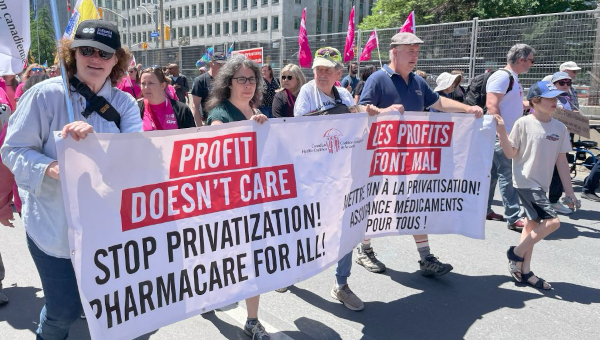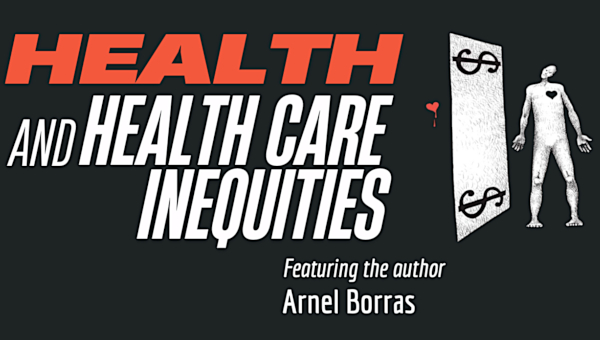An interview with Robert Chernomas by Robin Chang
In North American debates over healthcare, Canada’s universal public ‘single-payer’ system of health insurance is often celebrated compared to the private employer-delivered system for being lower cost, more accessible, and producing superior health outcomes. But recently, the Canada Health Accord has ended, and ‘Obamacare’ has been installed, which are major developments in the political economy of healthcare financing in both countries. In both cases, it appears that neoliberalism’s tendency for the state to assist in the privatization of the public sector is very strong in the advanced capitalist societies of North America given the balance of class forces and the condition of capital accumulation, even though from an efficiency standpoint, the Canadian model does seem to be superior. Since the financial and economic crisis of 2008, how can the structural changes in healthcare in Canada and the U.S. be understood by healthcare activists and researchers?
Robert Chernomas is based in the Department of Economics at the University of Manitoba and specializes in the political economy of healthcare. He has published on the political economy of neoliberalism in Canada and the U.S. and the political economy of the welfare state in advanced capitalist societies. His most recent book, co-authored with Ian Hudson, is To Live and Die in America: Class, Power, Health and Health Care (2013).
Robin Chang is in the Department of Political Science at York University, where he studies Marxian political economy and is writing his dissertation on the political economy of health and healthcare in Canada and the United States.
Austerity, Capitalism and Healthcare
Robin Chang: How would you characterize the pressures on healthcare systems in this phase of capitalism, and neoliberal policies across the advanced capitalist world, understanding that the crisis continues and that austerity seems to be the widely accepted model for state economic policy even for social democratic nations?

Robert Chernomas: With respect to the health sector it is hard to generalize – it depends to a great extent on the degree of class power and class interests in the U.S. and Canada. The Canadian branch of the auto sector has been a supporter of maintaining and expanding Medicare to include drugs and home care no doubt because the costs of healthcare built into every car is about a quarter of the costs of healthcare built into a U.S. car. Because Medicare is so universally supported in Canada they can afford to assert their interests whereas in the U.S. the tradable goods sector fraction of their capitalist class has been muted with respect to the efficiency of public sector healthcare by a more powerful general business class enmity of anything that suggests that profit is not the cure.
Years ago I was a visiting professor at the Johns Hopkins School of Public Health when the Vice President of Ford in charge of benefits gave a lecture complaining about the cost of healthcare in the U.S. and its affect on Ford’s competitiveness. He provided a buffet of alternatives including a Canadian single-payer option. In private I asked him why Ford doesn’t support the obvious choice – the Canadian system – he said he would in a heartbeat but Ford was a member of a number of corporate advocacy organizations like the National Association of Manufacturers who were opposed to such advocacy. We have analyzed the failure of the U.S. to implement an efficient and universal healthcare system in chapter five of our book To Live and Die in America. New York Times columnist Nobel Prize winning trade theorist Paul Krugman has called for a Canadian style single-payer system to repay U.S. workers for their losses due to free trade and to reduce the U.S. trade deficit. They got Obamacare instead.
Chang: Does Obamacare reflect and reinforce the tendency for the privatization of everything in the USA?
Chernomas: It isn’t clear that this is the case. On one hand the insurance companies will be guaranteed more business and profits because Obamacare requires their use. On the other hand they cannot refuse to
insure you because you are sicker (adverse selection) which if actually enforced could reduce their profits. So-called ‘Cadillac’ plans will be taxed as well while there will be an increase in corporate taxes to pay for Obamcare. It isn’t clear that the partly
private U.S. system will be any more or less private with Obamacare. The Bush drug plan for seniors didn’t increase the privatization of U.S. healthcare but did socialize the costs and secured profits for the drug companies.
The ‘Medical-Industrial’ Complex

Chang: Your book To Live and Die in America: Class, Power, Health, and Health Care written with Ian Hudson was published in 2013 and describes how a ‘medical-industrial complex’ developed in the United States, which in defending its self-interest uses resources to frustrate single-payer reform. Given that you have written a great deal about the Canadian system, in addition to the political economy of the welfare state, could you comment on the extent to which there exists an analogous complex inside Canada, with regards public-private partnerships (or ‘P3s’)? In what ways might the logic of capital accumulation shape how it is that given social classes, who pays in what share, who gets and when, and who gets paid and how much with respect to healthcare?
Chernomas: Canada relies on the Medical-Industrial-Complex (MIC) for much of its drugs, hi tech machinery and supplies. (In brief the MIC is the profitable link between doctors, hospitals and medical schools on one
hand and the more corporate side of the industry like insurance companies, drug manufacturers, and medical equipment suppliers on the other). The difference is the public sector restricts the proliferation of inefficient and iatrogenic MIC products. P3s are not so much a product of the MIC but Harper commitment to profits over efficiency throughout the public sector. I have recommended elsewhere including to the Romanow Commission that we build our own drug sector following the Crown corporation model. The idea here would be to bring the rest of the health sector under public control.
Since the inception of Medicare there has been a significant reallocation of health resource to the poorest and most in need of healthcare among us while others have had increased access to healthcare. We spend significantly less than our American neighbors, somewhat less than Germany and France and somewhat more than the UK and Japan.
Chang: You have written with political economist Fletcher Baragar that a major factor in the slowdown in economic growth during neoliberalism and the causes of the current crisis in the U.S. has to do with the extent of what classical political economists and Marx called unproductive labour, of which finance occupies a considerable share. How might the concept of unproductive labour be used to understand better the relationship between the level of healthcare spending with employment, profits, and economic growth if much of the added cost of the U.S. system is by many accounts due to administrative and other activities that consume rather than create ‘wealth’?
Chernomas: A significant proportion of the excessive health expenditures in the U.S. are accounted for by their use of private insurance companies to administer their healthcare system. The profits, marketing, advertising, risk assessment and detailed paperwork of their insurance industry makes no contribution to the actual provision of healthcare but is significantly more costly than either the Canadian public sector bureaucracy or even U.S. public sector bureaucracies like Medicare or the Veteran’s administration. The insurance industry does not produce anything and classical and Marxist analysis would refer to these economic activities as unproductive. Imagine in the neoliberal era saying out loud that the public sector is more efficient.
‘Single-Payer’ Universal Healthcare in Canada Under Threat
Chang: The 2004 Health Accord, a 10-year healthcare funding agreement between federal and regional governments guaranteeing the latter an annual 6 per cent increase in healthcare funding has recently ended. As a result, the Canada Health Transfer will now increase each year directly with gross domestic product, with a 3 per cent floor. According to journalist Wendy Glauser:
“That means the provinces and territories will receive $36-billion less over the next 10 years (based on an annual economic growth projection of 4 per cent), according to research by the Council of the Federation, a body comprising Canada’s 13 premiers…[In effect,] the federal government is balancing its budget, ‘on the backs of the provinces,’ said Adrienne Silnicki, the healthcare campaigner for the Council of Canadians, a social justice advocacy group. ‘It’s forcing them to de-list needed services and invite in more private healthcare providers.’”
Chang: Advocates for the privatization of Medicare in Canada claim that the rate of growth in costs can be reduced most effectively through ‘market discipline.’ But isn’t the U.S. well known for its much higher level of healthcare spending? What does this, in your opinion, say about the general direction of state economic policy with respect to healthcare in Canada? Who do you think could stand to benefit from these changes to the funding structure of Medicare?
Chernomas: The Harper regime has a two-fold strategy to undermine Medicare. The clever approach that Adrienne Silnicki describes above will underfund Medicare creating “shortages” over the medium run without making a politically unwise frontal attack. The other passive aggressive
strategy is to allow the more conservative (Liberal and Tory) provinces to privatize without using federal fiscal power to prohibit
this trend as employed by Liberal Health Minister Monique Begin in 1984 with the Canada Health Act (CHA). Actually the Harper strategy is to ignore the CHA.
| Table 1. Total healthcare expenditure as a per cent of GDP | |||||||
|---|---|---|---|---|---|---|---|
| 1990 | 2000 | 2005 | 2008 | 2009 | 2010 | 2011 | |
| Canada | 8.9 | 8.8 | 9.8 | 10.3 | 11.4 | 11.4 | 11.2 |
| France | 8.4 | 10.1 | 11 | 11 | 11.7 | 11.7 | 11.6 |
| Germany | 8.3 | 10.4 | 10.8 | 10.7 | 11.8 | 11.5 | 11.3 |
| Italy | 7.7 | 7.9 | 8.7 | 8.9 | 9.4 | 9.4 | 9.2 |
| Japan | 5.8 | 7.6 | 8.2 | 8.6 | 9.5 | 9.6 | — |
| Sweden | 8.2 | 8.2 | 9.1 | 9.2 | 9.9 | 9.5 | 9.5 |
| UK | 5.8 | 7 | 8.3 | 9 | 9.9 | 9.6 | 9.4 |
| USA | 12.4 | 13.7 | 15.8 | 16.6 | 17.7 | 17.7 | 17.7 |
| OECD avrg | 6.9 | 7.8 | 8.7 | 8.9 | 9.6 | 9.5 | 9.3 |
Source: OECD Health Data 2013.
Note: *OECD average for the period 2009-11 calculated based on the most recent data available for all countries.
The survey of the literature in our book To Live and Die in America makes clear that privatized/for-profit healthcare is less
efficient, less effective and significantly more unequal that single-payer public healthcare systems. It is important to remember the public sector portion of the health sector has effectively controlled costs over the past forty years (hospitals, physicians and administration). It is the private sector (e.g. drugs) that has driven Medicare’s increased costs. Marc-Andre Gagnon has written a report for the CCPA [The Economic Case for Universal Pharmacare] that argues bringing drugs under the control of the public system could reduce expenditures from $25-billion to $15-billion; provide universal access and improved efficacy.
The Harper strategy will increase health expenditures and reduce access while a more complete public healthcare sector would have billions more to spend on real problems like waiting lists without increasing costs to the taxpayer.
| Table 2. Public spending as a per cent of all healthcare expenditure | |||||||
|---|---|---|---|---|---|---|---|
| 1990 | 2000 | 2005 | 2008 | 2009 | 2010 | 2011 | |
| Canada | 74.5 | 70.4 | 70.2 | 70.5 | 70.9 | 70.8 | 70.4 |
| France | 76.6 | 79.4 | 77.7 | 76.8 | 77 | 76.9 | 76.8 |
| Germany | 76.2 | 79.5 | 76.6 | 76.4 | 76.8 | 76.7 | 76.5 |
| Italy | 79.5 | 74.2 | 77.9 | 78.9 | 78.9 | 78.5 | 77.8 |
| Japan | 77.6 | 80.8 | 81.6 | 81.4 | 81.5 | 82.1 | — |
| Sweden | 89.9 | 84.9 | 81.2 | 81.5 | 81.5 | 81.5 | 81.6 |
| UK | 83.6 | 79.1 | 80.9 | 81.1 | 82.6 | 83.5 | 82.8 |
| USA | 39.4 | 43 | 44.2 | 46 | 47.2 | 47.6 | 47.8 |
| OECD avrg | 69.4 | 69.12 | 69.07 | 71.04 | 71.44 | 70.39 | 72.2 |
Source: OECD Health Statistics 2013.
So what are the real motives behind the claims of Medicare’s unsustainability?
First and foremost the fact that healthcare in Canada, in large part, like education and some hydro is beyond the grasp of the for-profit system is maddening for those who might profit from it. The Medicare part of healthcare in Canada is part of the commons, not a commodity to be sold in a marketplace for profit. The for-profit delivery of hospital and physician services under Medicare is prohibited by the Canada Health Act. It is in principle a system of each according to their ability to each according to their need. For those who are driven to make profits it does not matter that healthcare is delivered more efficiently, effectively and is more accessible by the public sector, by definition it is in need of privatizing. This public system is sufficiently popular in Canada that it has to be undermined by stealth as I will describe below.
Second, as Robert Evans argues with Canada’s universal tax-financed Medicare, higher-income people contribute proportionately more to supporting the healthcare system, without receiving preferred access or a higher standard of care. Any shift to more private financing would reduce the relative burden on those with higher incomes and offer (real or perceived) better or more timely care for those willing and able to pay. Of course ironically as suggested above, the profits to be made by a for-profit medical sector would make other sectors, especially those like autos, buses, aircraft, agriculture and resources that depend on trade lose a competitive advantage.
The more salient question would be is the Canadian economy sustainable without Medicare?
Publicly delivered universal healthcare means a more efficient economy where our products and services are relatively less costly, leaving resources available for education, research and development, a living wage and a green economy.
Chang: Following on your last point, the short term interests of the capitalist class has led to reducing state spending, shifting the healthcare cost burden to other social classes, and expanding the market for capitalist business. But privatizing healthcare and allowing for a medical-industrial complex to bloom in the ‘market’ is harmful in the long run because of the inefficiencies that this creates for the overall economy by increasing the cost of healthcare, never mind the social costs of undermining the ability for working-class people to access healthcare and live as long and healthy as the capitalist class.
The Canadian experience shows that single-payer healthcare is possible in advanced capitalism, but that powerful interests in society are never entirely comfortable with the existence of ‘barriers’ to their further economic expansion. How can the working-class counteract the tendency toward privatization? The real challenge is to continue develop radical social movements, such as the Canadian Health Coalition and Ontario Health Coalition and Physicians for a National Health Program in the U.S., and integrate these struggles as part of anti-neoliberal coalitions and united fronts. Defending universal healthcare in Canada, installing it in the U.S., and protecting decommodified healthcare elsewhere depends on the ability of the working-class to demand it and force capitalists to accept it into the political economy. It might be the case that given the point at which neoliberalism has developed, universal healthcare will require confronting both neoliberalism and capitalism as a whole. •





